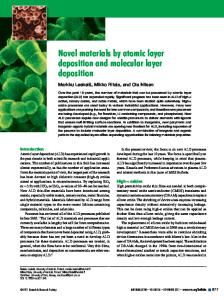Atomic Layer Deposition of Ruthenium Films on Hydrogen terminated Silicon
- PDF / 340,755 Bytes
- 6 Pages / 612 x 792 pts (letter) Page_size
- 41 Downloads / 433 Views
1156-D04-02
Atomic Layer Deposition of Ruthenium Films on Hydrogen terminated Silicon S. K. Park,1 K. Roodenko,1 Y. J. Chabal,1 L. Wielunski,2 R. Kanjolia,3J. Anthis,3 R. Odedra,3 and N. Boag,4 1 Materials Science and Engineering Department, University of Texas at Dallas, Richardson, Texas 75080, USA 2 Laboratory for Surface Modification, Rutgers University, Piscataway, NJ 08854, USA 3 SAFC Hitech, Haverhill, MA 01832, USA 4 Functional materials, Institute for Materials reasearch, University of Salford, Salford, Manchester M5 4WT, UK ABSTRACT Atomic Layer deposition of thin Ruthenium films has been studied using a newly synthesized precursor (Cyclopentadienyl ethylruthenium dicarbonyl) and O2 as reactant gases. Under our experimental conditions, the film comprises both Ru and RuO2. The initial growth is dominated by Ru metal. As the number of cycles is increased, RuO2 appears. From infrared broadband absorption measurements, the transition from isolated, nucleated film to a continuous, conducting film (characterized by Drude absorption) can be determined. Optical simulations based on an effective-medium approach are implemented to simulate the in-situ broadband infrared absorption. A Lorentz oscillator model is developed, together with a Drude term for the metallic component, to describe optical properties of Ru/RuO2 growth. INTRODUCTION Ruthenium and ruthenium oxides exhibit high chemical and thermal stabilities in presence of high-κ dielectric materials such as hafnium oxide and aluminum oxide.1 Additionally they have relatively high work functions, which is important for gate metals.2 Thus, they are expected to provide a barrier and seed layer for copper deposition, an important interconnection material in microelectronics, a capacitor electrode material for memory devices, and a gate metal for metal-oxide-semiconductor field effect transistors.1, 3-8 There has therefore been an increased effort to study the deposition of Ru and RuO2 using different growth techniques.2, 9-11 Since atomic layer deposition is a powerful method to deposit thin, uniform, and conformal films even on structured surfaces such as trenches and via holes, there is an active search for ruthenium ALD precursors possessing appropriate physical and chemical properties for the deposition process. In this study, we present in-situ Fourier transform infrared (FTIR) studies of ALD growth of ruthenium thin films on hydrogen-terminated silicon (111) surfaces using cyclopentadienyl ethylruthenium dicarbonyl precursor [Ru(Cp)(CO)2Et], one of the newly synthesized cyclopentadienyl dicarbonyl alkyl ruthenium precursors, with O2 as oxidant. The broadband infrared absorption obtained from in-situ FTIR measurements is simulated using optical models, in order to obtain an idea of evolution of the Ru, RuO2 and SiO2 species on the surface.
EXPERIMENTAL PROCEDURES AND MODELING For this study, double-sided polished, Si (111) wafers are passivated with hydrogen by an immersion in HF and NH4F after a standard RCA clean, followed by deionized water rinse and a
Data Loading...







